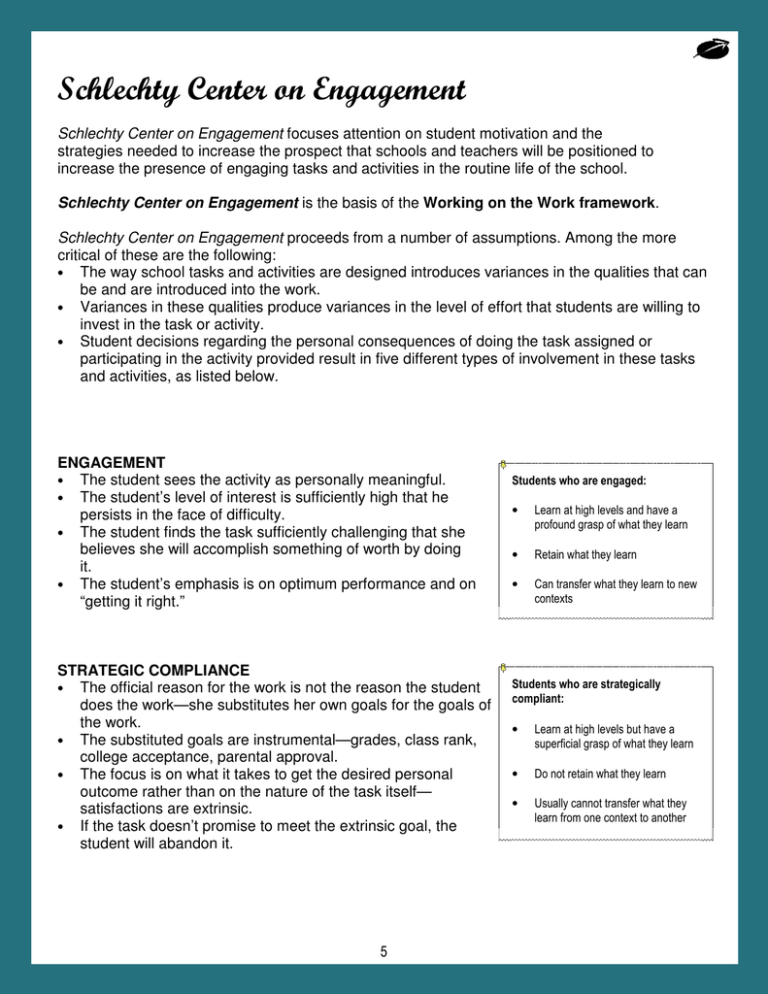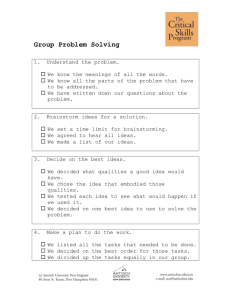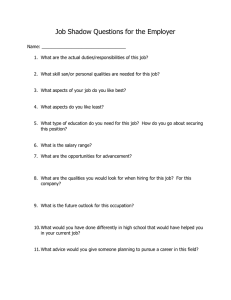Schlechty Center on Engagement
advertisement

Schlechty Center on Engagement Schlechty Center on Engagement focuses attention on student motivation and the strategies needed to increase the prospect that schools and teachers will be positioned to increase the presence of engaging tasks and activities in the routine life of the school. Schlechty Center on Engagement is the basis of the Working on the Work framework. Schlechty Center on Engagement proceeds from a number of assumptions. Among the more critical of these are the following: • The way school tasks and activities are designed introduces variances in the qualities that can be and are introduced into the work. • Variances in these qualities produce variances in the level of effort that students are willing to invest in the task or activity. • Student decisions regarding the personal consequences of doing the task assigned or participating in the activity provided result in five different types of involvement in these tasks and activities, as listed below. ENGAGEMENT The student sees the activity as personally meaningful. The student’s level of interest is sufficiently high that he persists in the face of difficulty. • The student finds the task sufficiently challenging that she believes she will accomplish something of worth by doing it. • The student’s emphasis is on optimum performance and on “getting it right.” • • STRATEGIC COMPLIANCE • The official reason for the work is not the reason the student does the work—she substitutes her own goals for the goals of the work. • The substituted goals are instrumental—grades, class rank, college acceptance, parental approval. • The focus is on what it takes to get the desired personal outcome rather than on the nature of the task itself— satisfactions are extrinsic. • If the task doesn’t promise to meet the extrinsic goal, the student will abandon it. 5 Students who are engaged: • Learn at high levels and have a profound grasp of what they learn • Retain what they learn • Can transfer what they learn to new contexts Students who are strategically compliant: • Learn at high levels but have a superficial grasp of what they learn • Do not retain what they learn • Usually cannot transfer what they learn from one context to another RITUAL COMPLIANCE • The work has no meaning to the student and is not connected to what does have meaning. • There are no substitute goals for the student. • The student seeks to avoid either confrontation or approbation. • The emphasis is on minimums and exit requirements—what do I have to do to get this over and get out? Students who are ritually compliant: • Learn only at low levels and have a superficial grasp of what they learn • Do not retain what they learn • Seldom can transfer what they learn from one context to another RETREATISM Students who are in retreat The student is disengaged from current classroom activities and goals. • Do not participate, and therefore • The student is thinking about other things or is emotionally learn little or nothing from the task withdrawn from the action. or activity assigned • The student rejects both the official goals and the official means of achieving the goals. • The student feels unable to do what is being asked or is uncertain about what is being asked. • The student sees little that is relevant to life in the academic work. • REBELLION • The student is disengaged from current classroom activities and goals. • The student is actively engaged in another agenda. • The student creates her own means and her own goals. • The student’s rebellion is usually seen in acting out—and often in encouraging others to rebel. Students who are in rebellion: • Learn little or nothing from the task or activity assigned • Sometimes learn a great deal from what they elect to do, though rarely that which was expected • Develop poor work habits and sometimes develop negative attitudes toward intellectual tasks and formal education Teachers can enhance the prospect of students’ being engaged in the tasks and activities they want them to be engaged in by attending carefully to building into the work they provide those qualities that are most likely to appeal to the values, interests, and needs of the students involved. Phil Schlechty refers to these as Design Qualities. There are two distinct sets of Design Qualities to which teachers might attend. These are Design Qualities of Context and Design Qualities of Choice. Design Qualities of Context are those aspects of tasks and activities that are ubiquitous and will affect student engagement even when the teacher does not intentionally take them into account. Design Qualities of Choice are qualities that the teacher can choose to include or to omit, depending on the teacher’s judgment regarding the needs and interests of students. 6 DESIGN QUALITIES OF CONTEXT There are four Design Qualities of Context: • Content and Substance, which refers to what is to be learned and the level of student interest in the subject or topic. • Organization of Knowledge, which refers to the way the work is organized—for example, using a problem-solving approach, discovery approach, or didactic teaching—with consideration for the learning styles that are assumed or are to be addressed. • Clear and Compelling Product Standards, which refers to the extent to which students are clear about what they are to do, what the products they produce should look like, what standards will be applied to evaluate these products and their performances, and how much value students attach to the standards that are to be used; that is, do the students believe in the standards and see them as personally compelling? • Protection from Adverse Consequences for Initial Failures, which refers to the extent to which the task is designed so students feel free to try without fear that initial failures will bring them humiliation, implicit punishment, or negative sanctions. DESIGN QUALITIES OF CHOICE There are six Design Qualities of Choice: • Product Focus, which refers to the opportunity to structure tasks and activity so that what students are to learn is linked to some product, performance, or exhibition to which the student attaches personal value. • Affirmation of Performance, which refers to the possibility of designing tasks and activities so that the performance of students is made visible to persons who are significant in their lives, as well as designing the work in ways that make it clear that the quality of the performance of the student has meaning and value to peers and others whose opinions the student values and cares about. • Affiliation, which refers to the possibility of designing tasks so that students are provided the opportunity to work with peers as well as with parents, outside experts, and other adults, including but not limited to the teacher. • Novelty and Variety, which refers to the possibility of providing students the opportunity to employ a wide range of media and approaches when engaged in the activities assigned and encouraged. • Choice, which refers to the possibility of designing tasks and activities so that students can exercise choice either in what they are to learn or how they go about learning that which it is required that they learn. • Authenticity, which refers to the possibility of linking learning tasks to things that are of real interest to the student, especially when the student is not interested in learning what adults have determined he or she needs to learn. The primary task of the teacher is to design engaging tasks and activities for students that call upon students to learn what the school has determined they should learn and then to lead students to success in the completion of these tasks. Teachers are, therefore, designers and leaders, and the role of teacher needs to be redefined to reflect this view. To redefine the role of teacher, it will also be necessary to redesign every other role in the school, including the roles of the superintendent, the board of education, and central office personnel, as well as principals and parents. All of this redesign must reflect a clear understanding and acceptance of the fact the schools should be organized to nurture engagement rather than to produce attendance and compliance. 7 Schlechty Center 950 Breckenridge Lane, Suite 200 Louisville, KY 40207 502.895.1942 502.895.7901 fax www.schlechtycenter.org info@schlechtycenter.org



